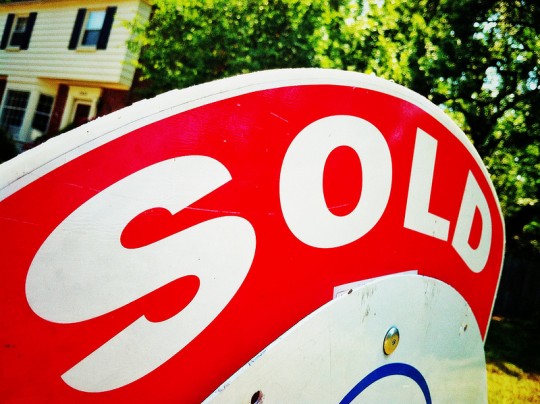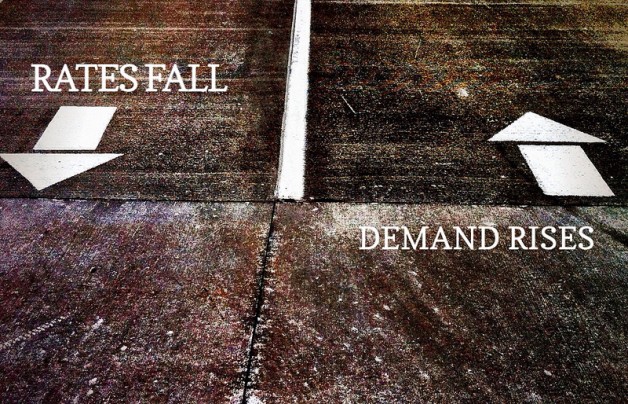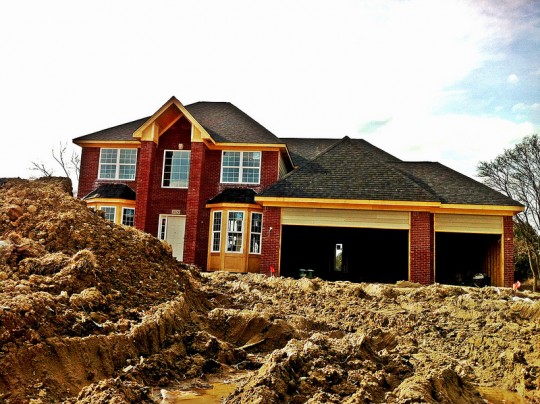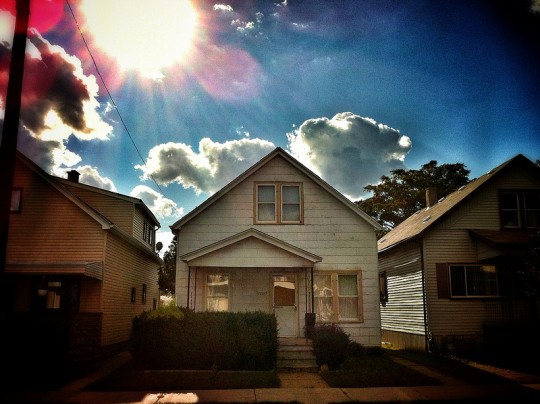Sales of new single-family homes spiked in August, according to estimates released by the U.S. Census Bureau and the Department of Housing and Urban Development. Sales were up 7.9 percent above July’s rate and 12.6 percent above last year’s estimates. The improvement is a welcome change following a nearly 14 percent plunge in July, which was the largest drop in more than three years. And, though August’s estimates fell slightly below economists’ expectations, the late summer lull has been caused by temporary factors, according to analysts. Merrill Lynch, for example, is forecasting that builders will sell 438,000 new homes this year and that sales will rise by more than 20 percent next year. The government report also showed that the median sales price of new houses sold in August was $254,600; the average sales price was $318,900. There is a 5-month supply of new homes available for sale at the current sales rate. More here and here.
Archive for Uncategorized
Mortgage Demand Increases As Rates Fall
According to the Mortgage Bankers Association’s Weekly Applications Survey, demand for mortgage loans was up 5.5 percent last week from the week before. The increase included a 7 percent spike in demand for purchase loans and a 5 percent gain in the number of people requesting applications to refinance their home. The Purchase Index was at its highest level since July. The survey also found the average contract interest rate for 30-year fixed-rate mortgages fell again last week for all loan types. But despite the drop in rates, the refinance share of total mortgage activity was unchanged from the previous week at 61 percent. The survey, which the MBA has been conducting weekly since 1990, covers 75 percent of all U.S. retail residential mortgage applications. More here.
Home Prices Rise, Though Rate Of Increase Slows
The S&P/Case-Shiller Home Price Indices, considered the leading measure of U.S. home prices, showed values continuing to improve in their latest release. The report found that prices rose more than 12 percent from last year in both the 10-city and the 20-city composites. The 20-city composite index also saw month-over-month gains for the fourth consecutive month, though the rate of those gains slowed in July as compared to June. David M. Blitzer, chairman of the index committee at S&P Dow Jones Indices, said that, though all 20 included cities are up month to month, more cities are experiencing slower gains each month, which suggests the rate of price increases may have peaked. Also, Blitzer believes housing will see a limited, though favorable, impact due to the Fed’s announcement that they will continue their bond-buying program. More here and here.
Continuation Of Fed Program Alters Rate Forecast
Federal efforts to support the ailing economy and strengthen the housing market began in 2009. The effects of these efforts have kept mortgage rates down and housing affordability high, resulting in a rebounding market and increasingly healthy economy. Because of this, expectations that the Federal Reserve would begin winding down its bond-buying program, have led to an increase in mortgage rates and forecasts of a coming economic slowdown. But, despite indicating the program would be cut back by the end of this year, the Fed recently announced it would continue the program and insisted there is no preset course or schedule for ending the purchases. Analysts expect that the continuation of the program will result in a break from the increases in mortgage rates seen over the past few months. More here and here.
New Home Construction On The Rise
According to the U.S. Census Bureau and the Department of Housing and Urban Development, permits to build new single-family homes rose 3 percent in August, reaching their highest level since 2008. The improvement, combined with a 7 percent jump in single-family housing starts, provides more evidence of a consistent and sustained recovery in the residential housing market. And, in addition to the obvious benefits to housing, gains in new-home construction are closely tied to the broader economy. In fact, economists’ estimate that every new home built leads to the creation of three jobs for a year. Demand for new homes is expected to continue, as household formation numbers recover from historic lows. More here and here.
Existing Home Sales Up in August
Sales of previously owned homes rose in August, according to the National Association of Realtors. Total existing-home sales increased 1.7 percent from the month before and were 13.2 percent above year-before levels. Regionally, sales were up in the Midwest and South, flat in the Northeast, and down in the West. But, despite reaching the highest sales pace since February 2007, Lawrence Yun, NAR’s chief economist, said the market may be experiencing a temporary peak. Yun cautioned that sales may be uneven in the months ahead due to tight inventory and less favorable affordability conditions. In short, fewer homes for sale puts upward pressure on prices. In fact, the median home price in August was up nearly 15 percent from 2012 and has posted double-digit increases for nine consecutive months. More here.
Average Mortgage Rate Dips, Refinance Demand Surges
A drop in the average contract interest rate for 30-year fixed-rate mortgages caused an 11.2 percent spike in demand for mortgage applications last week, according to the Mortgage Bankers Association’s Weekly Mortgage Applications Survey. The increase was due, in part, to an 18 percent surge in the Refinance Index and a 3 percent jump in the seasonally adjusted Purchase Index. The previous week saw a 13.5 percent drop in overall demand for mortgage applications, despite an adjustment for the Labor Day holiday. Last week’s recovery brought demand back to nearly the same level as before the holiday. More here and here.







